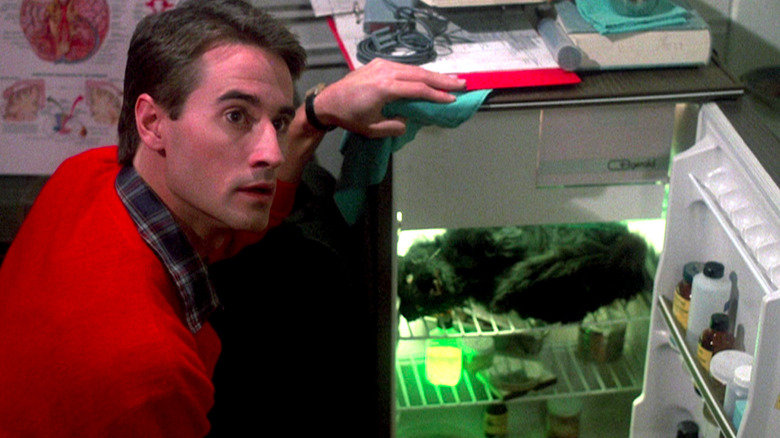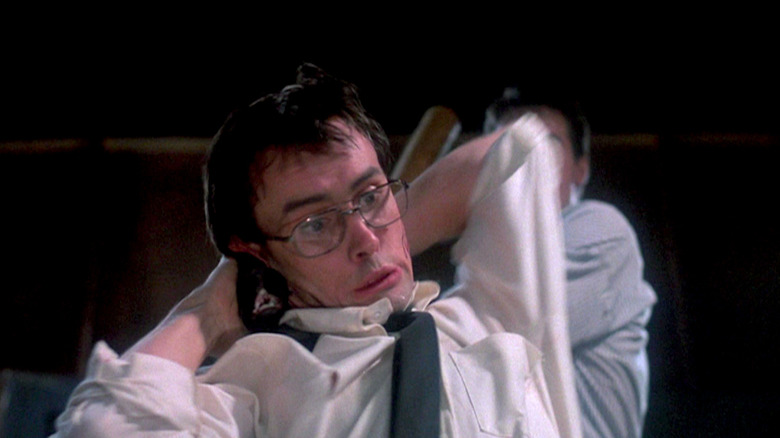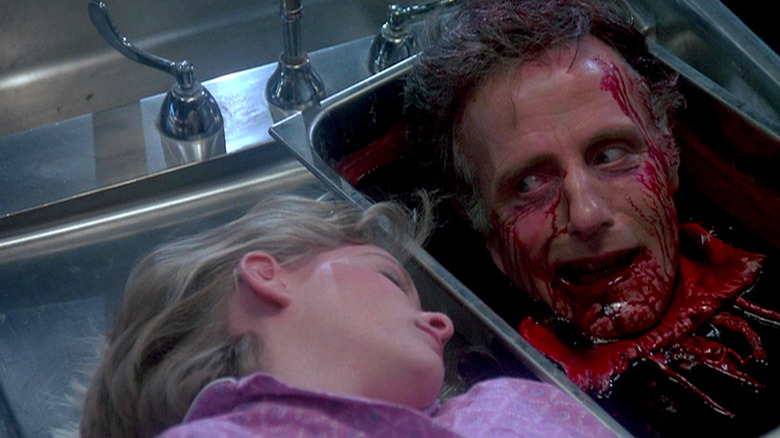Setting The Tone For Re-Animator Was A Delicate Balancing Act
If you're a fan of Stuart Gordon's wild 1985 horror-comedy "Re-Animator" based on H.P. Lovecraft's story "Herbert West – Reanimator," then there is no doubt you know the movie is absolutely bonkers. Sure, when you read the plot for the film, it sounds pretty wild. Medical student Herbert West (played by the always dreamy Jeffrey Combs) develops a serum — a reagent if you will — that has the potential to bring dead people back to life, and in an attempt to conduct studies with said reagent, West enlists the help of another medical student Dan Cain to help him gain access to the hospital morgue and the plethora of bodies within. A dead cat and a severed head later, things have gone horribly awry, and everyone just seems to be fighting for their lives. The movie's brilliance though lies in its often crass delivery and out-of-control gags that only seem to increase in shock value as the story progresses.
Perhaps the peak of the film's crassness occurs during that scene, the one involving a very much still alive severed head attempting to do unspeakable things to a very naked and tied down Barbara Crampton as she writhes on a gurney attempting to avoid sexual assault. The scene would be utterly cringeworthy (and may still be for some) if it wasn't so damn bizarre, and that is the brilliance of "Re-Animator." Somehow, it manages to get away with some pretty incredibly offensive things and still make the audience laugh in disgust. That's not to say it's a movie for everyone (it's definitely not), but it is impressive for the tightrope it manages to walk on its journey through a wild "I can't believe they just did that" film. And finding the right tone wasn't easy.
The difference between comedy and fear
In the 1985 director's commentary for the film, Stuart Gordon talks a bit about how he believes that comedy and fear cannot exist within the same scene. "Laughter is the antidote for fear," he explains. "So, what you can do is you can build tension, and then relieve it with laughter, and then crank it up again. But you can't do both at the same time, they cancel each other out." This desire to create tension only to defuse it with comedy is at the core of the "Re-Animator" recipe for success. There are plenty of scary or appalling things that occur within the film, but Gordon always seems to know just when to cut the tension with humor in order to prevent the movie from going too far.
A great example of this is the scene in which Dan goes to investigate some horrifying sounds coming from the basement, only to realize that Herbert has reanimated his dead cat, which is now a rabid zombie animal that is trying to attack them both. There is tension in the scene before you realize what is going on, and then, almost like a switch, the tension turns into comedy as the cat yowls like a kid playing race cars with his Hot Wheels and the two men scramble to re-kill the possessed animal. The ridiculousness of the scene is a bit of a taste of things to come so that by the time we get to the whole Barbara Crampton/severed head debacle, we've become accustomed to Gordon's method of relieving tension with comedy so that we can allow ourselves to laugh instead of recoil.
The importance of a tight knit cast
Even Gordon himself knows that the movie spirals into a completely ridiculous film in its second half. In the commentary, he says, "From the point where we've got Dr. Hill carrying his head around, the movie starts sort of veering into the more outrageous and becomes more comical as it goes from here," and this is largely due to Gordon's subtle fear versus humor technique that he's been inundating his audience with from the very beginning of the film. It allows him to get away with quite a lot, but with just his direction alone, the movie would not have been able to pull off such tomfoolery. To do that successfully, the actors had to be in total sync with one another.
In an interview for Paste, Gordon explains how he used his previous background in theater to help shape the way the actor's understood their characters and what motivated each of them to do what they were doing. To achieve such a cohesive tone between each individual actor, the cast participated in rigorous read-throughs before filming even began. "We rehearsed for two weeks at Barbara Crampton's apartment, during which we treated the scenes in order as if it were a play, because I knew that when we started shooting we wouldn't have time to talk about motivation and things like that," Gordon explains. "That really got everyone comfortable with each other and the script."
If it weren't for the cohesiveness of the cast and the beautifully navigated scenes of tension and humor, "Re-Animator" had the potential to be an over-the-top film that at the very least wasn't funny, and at the worst was actually pretty disturbing. But Gordon pulled it off, creating one of horror's best comedies that will hopefully never die. Though if it does, we know just who to call for a quick resuscitation.


